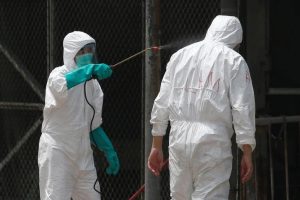Janjivan Bureau
SHANGHAI : Four years ago, a bird flu outbreak in China killed at least three dozen people, triggered mass poultry culling, put masks on millions of Chinese faces and hammered shares in fast food and travel companies.
This winter, more than 100 people have died, but few birds have been slaughtered, there are few masks on the streets and little sign of any consumer reaction, let alone the panic seen in 2013.
The number of posts mentioning “bird flu” or “H7N9” on China’s popular Sina Weibo microblog – a useful proxy for gauging consumer interest or concern – peaked at just over 40,000 on Wednesday after the health ministry said as many as 79 people died from H7N9 bird flu in January alone.
At the peak of the 2013 outbreak, daily posts topped 850,000.
“Everyone’s just used to it now,” said Yuan Haojie, 24, a real estate worker in Shanghai. “Every year we seem to have some sort of bird flu outbreak, but it never seems to affect anyone I know. Gradually you stop worrying about it.”
The 2013 outbreak was the first in China of the H7N9 bird flu strain. The virus this year appears to be less pathogenic among poultry, which show few symptoms, but more deadly among humans in direct contact with infected birds at live markets and on farms.
Four years ago, the outbreak cost the economy an estimated $6.5 billion, took chicken off the menu at schools and on airplanes, and prompted the widespread slaughter of millions of birds. The biggest impact this year is that Chinese chicken prices have dropped to their lowest levels in more than a decade.
“In 2013, there was a great panic in the consumer market, and people were afraid to eat poultry,” said Pan Chenjun, Hong Kong-based senior analyst at Rabobank. “Consumer market sentiment now isn’t so bad. People are more resilient because coverage has been quite limited.”
Many consumers and fast food chain workers Reuters spoke to were unaware of the severity of this season’s outbreak.
“Is this one of those online rumours?” asked the duty manager at one KFC outlet in the northern mining city of Shuangyashan. The fried chicken brand is operated locally by Yum China Holdings Inc.
Yum, which reported a “significant, negative impact” during the 2013 outbreak, did not respond to requests for comment. The company’s U.S.-listed shares are down less than 5 percent so far this year.
A worker at local chicken chain Dicos in Shanghai said this winter’s bird flu outbreak had not hit sales, and the firm had not given staff any specific directives on how to respond to diners’ concerns.
Dicos, owned by Taiwan’s Ting Hsin International Group, declined to comment.
Global health bodies and government organisations in China have long said properly cooked chicken is not a safety risk.
Some netizens and experts have said Beijing was slow to respond to the outbreak this year and data on human infections and deaths was not disclosed soon enough.
China’s health authorities said on Thursday they would tighten controls on poultry markets and the transport of live birds, but noted the spread of the virus among people was slowing.
China’s Center for Disease Control and Prevention has said the vast majority of people infected by H7N9 reported exposure to poultry, indicating little person-to-person infection.
In southern Guangzhou, 24-year-old office administrator Li Lishan said there were bans on poultry markets in her area and people were quite worried about the disease. However, she said she was still eating chicken.
“The days before the trading ban I went crazy buying up chicken,” she said, acknowledging there was a risk. “I know, I know. I’m just used to eating it.”


















